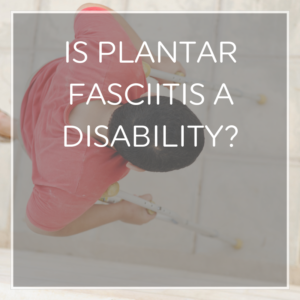 The answer to this question depends a lot on context. A disability can be medical–an injury or a limitation that affects how you live your life. Or a disability can be a legal classification that determines whether or not you’re able to receive different benefits (like Social Security disability benefits, or Veterans Administration benefits).
The answer to this question depends a lot on context. A disability can be medical–an injury or a limitation that affects how you live your life. Or a disability can be a legal classification that determines whether or not you’re able to receive different benefits (like Social Security disability benefits, or Veterans Administration benefits).
Plantar fasciitis can be both a medical disability and a legally-protected disability that may qualify you for medical treatment, insurance coverage, or disability benefits, depending on a few different factors. In this post, we’ll explore what qualifies plantar fasciitis as a legal disability, how plantar fasciitis disabilities are classified, and whether plantar fasciitis qualifies for VA disability.
What Qualifies Plantar Fasciitis as a Disability?
In the United States, the Americans with Disabilities Act (or ADA) defines the word “disability” in a legal sense, as a mental or physical condition that “Substantially limits one or more major life activity. This includes people who have a record of such an impairment, even if they do not currently have a disability. It also includes individuals who do not have a disability but are regarded as having a disability.”
Whether or not your plantar fasciitis qualifies as a disability in the legal sense or not, your pain and suffering are real. Heel pain and plantar fasciitis can be extremely debilitating, making it difficult to walk or participate in daily activities. Talk to your doctor about whether you may be eligible to get a Handicapped Parking Permit
Plantar Fasciitis can be considered a legal disability that qualifies you for Social Security disability benefits in the US under these conditions:
- You have severe plantar fasciitis that makes it difficult or impossible for you to work — and you can show that your particular job is difficult or impossible to perform with plantar fasciitis
- You can document that your plantar fasciitis has significantly interfered with or prevented you from working your work for at least a year–or would prevent you from working for at least a year.
- Your plantar fasciitis has been officially diagnosed and documented by a licensed doctor
- If you’re over age 50, your claim for benefits may be approved more quickly
If you believe that your plantar fasciitis may be considered a legal disability, you should talk to your doctor, then apply for disability benefits with the Social Security disability office. It’s important for you to keep records of all your doctor’s visits, work you’ve had to miss, or any other records that show how much plantar fasciitis has impacted your life. It’s also important to understand that the process of obtaining benefits can take some time, and some paperwork!
In countries outside of the US that use socialized medicine, obtaining disability may be less difficult, and you may qualify for benefits whether or not you are working. In the UK, the disability must be present (or seem likely to continue) for 9 months instead of one year. To find out whether or not you qualify for disability benefits outside of the United States, start by contacting your local branch of government to get the ball rolling.
How Is Plantar Fasciitis Classified as a Disability?

There isn’t a straightforward path for classifying plantar fasciitis as a disability in the Social Security’s Bluebook, which is a list of conditions and impairments that might qualify you for benefits.
Depending on your unique situation and the location of any heel spurs, you may be able to get SSA benefits under Section 1.02, Dysfunction of a Joint.
However, most people with plantar fasciitis end up qualifying for benefits under Social Security’s “RFC” (residual functional capacity) clause, an assessment that determines how severe your pain is, and how much it interferes with your ability to work.
In an RFC assessment, disability claims employees will perform an assessment to look at your limitations, your doctor’s documentation of which treatments you have tried, how long you’ve been suffering from plantar fasciitis, how the pain affects your daily life, and any medications you’re using. Keep in mind that, in general, the claims assessment is mostly a process of reading through documents. Some claims fail because a doctor didn’t fully and completely describe pain levels and intensity, or document just how much the condition impacts your life on a daily basis. Make sure you communicate with your doctor about this process, and how important thorough documentation is for your case.
Does Plantar Fasciitis Qualify for VA Disability?
VA disability assistance helps veterans who have served the United States recoup medical expenses for injuries they’ve sustained during military service or because of military service.
Many vets suffer from painful heels and feet from plantar fasciitis, which can make walking, moving, or living life difficult. The VA may also approve claims for depression caused by the pain from chronic plantar fasciitis, foot deformities that lead to the collapse of the arch, sciatica, or back and knee problems that are related to plantar fasciitis.
Depending on how severe your pain and disability from plantar fasciitis is, the VA benefit will rank your condition on a scale from 10-100 (with 100 being the most severe and eligible for the most benefits).
Similar to the SSA, a VA disability claim for plantar fasciitis will need to be submitted to the VA and evaluated, so the more you and your doctor can document your condition, treatments, and your pain level the better your chances of receiving appropriate benefits.
The pain from plantar fasciitis can be truly debilitating–and disabling–especially when the condition is chronic. Whether or not your unique situation qualifies for disability benefits with the SSA or VA, you deserve support and relief from family, friends, and other plantar fasciitis sufferers. And if you do decide to pursue disability benefits for your condition, remember to document your pain and your treatment process as thoroughly as possible, work together with your health provider to help them understand the types of details you need to document, and follow the claims submission and review steps outlined by the SSA or the VA to get the financial help you need.




I have chronic plantar fasciitis, heel spur and Arthritis , bunion, ingrown toenails on my feet
Pain everyday very painful to walk and to work. My knees are bad with arthritis also hard to function most days.
Very good information I feel it will be helpful as i seeking claim for disability. Thanks for sharing
I’m only 19 with planter fasciitis, fractured heel and bone spurs in both feet. Its excruciating to walk stand. I have to crawl to the bathroom. Use a Walker and shower chair, I cant go out to the mall with my friends I can’t stand long enough to go to Walmart and buy food. I would never wish anyone my pain I’m going through. I’ve did months of Physical therapy, I got the Injections I’ve done the cold water bottle night splintsheavy steroids to treat inflammation everything. I got $700 inserts for my feet and nothing works. I have to quit my job because I’m no longer able to keep up with out taking breaks every 15 mins. I do not want to go on disability but I honestly think it’s my last option.
Wow, I am so sorry you have to go through this! I have been going through this since the end 2002. I have had both feet operated one at the same time in May of 2004, for Plantar Fasciitis. And until this day my life has never been the same. I have crawled on the floor many of to the bathroom at home, I had to go on unemployment for medical leave do to not being able to walk because I have other problems with my feet. Now, I am 38 yrs old, I wear braces on both feet and ankles. It effects me every day. I went through physical therapy also, it helps some. But the fatigue and depression you get from the debilitating pain is awful & I feel your pain.
I also have flat feet to go with all of that too. As well as I pro-nate inward.
There is a shot u can get not cortizone its a numbing shot I got it 10 years ago and i am pain free.check into it
I have severe plantar fasciitis and have shortened heel tendons having surgery soon. They told me that this doesn’t qualify me to be on disability. Trying to figure out next step. Been in pain since I was born and my feet and legs are giving out.
I’m 47 and I too have plantar faciitis. I am in pain every day. While laying down I have shooting pains in my heels that go up my legs.
I have to limp to go to the bathroom. My Doctor gave me Ibuprofen 800 mg but it ended up giving me stomach inflammation. I limp every where I go.
Sometimes I just can’t get outta bed due to the pain. The heels of my feet are in excruciating pain. I’m going to ask my Doctor for some crutches or something. Inserts & different shoes don’t work either.
I have to apply for Disability.
I can barely walk let alone stand up enough to hold a job or do minor errands. I wouldn’t wish this on my worst enemy. I feel like such a loser because I can’t work or do errands due to this condition.
I’m 53 with severe plantar fasciitis and was wondering how hard it was for you to get your disability started?
Plantier Facitis shoes help a great deal. Check on the internet. I have to use extra padding under the heels, but the shoes help a great deal.
I’m very sorry that everyone is in pain.My feet have been killing me for yrs! I work 12 hr shifts and been doing this for 20 yrs.God bless all of you On here!🙋😇
the shoe inserts practically cured my PF for a year, but now it’s back and so painful. my job involves walking and i just don’t know if i can cope with walking on my toes or the sides of my feet. i would hate to be labeled disabled because i feel able bodied at 53, but walking is a nightmare. i had no idea this was considered a disability, and i hope people are getting the benefits if they can.
I’m 54 have hard time walking due to pain, tried the meds, the massages, shoes inserts, ect. Some times I can’t get out of bed to go to bathroom due to pain. Goes from feet to legs into hips now. Can’t hold job because if pain. Any suggestions. No income no insurance no job now☹